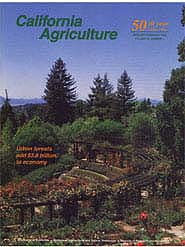


University of California
California Agriculture



|
|||
|
|||

Urban forests add $3.8 billion to economy
Cover:
The Rose Garden, a park in the city of Berkeley, is an example of urban forestry that provides residents with aesthetic, environmental and economic benefits. Photo by Jack Kelly Clark
January-February 1996
Volume 50, Number 1 |
|||
|
University of California, 1301 S. 46th St., Bldg. 478 Richmond, CA
|